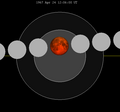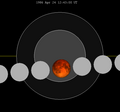April 2005 lunar eclipse
| Penumbral Lunar Eclipse 24 April 2005 | |
|---|---|
 From Minneapolis, Minnesota, with inset images of a full moon a few hours before the eclipse, and the setting moon at 9:55 UT near greatest eclipse. | |
 The Moon passed (right to left) through the Earth's southern penumbral shadow. | |
| Series (and member) | 141 (23 of 73) |
| Gamma | -1.0885 |
| Magnitude | 0.8650 |
| Duration (hr:mn:sc) | |
| Penumbral | 4:05:38 |
| Contacts (UTC) | |
| P1 | 7:52:06 |
| Greatest | 9:54:51 |
| P4 | 11:57:44 |
 The Moon's hourly motion across the Earth's shadow in the constellation of Virgo. | |
A penumbral lunar eclipse took place on Sunday 24 April 2005, the first of two lunar eclipses in 2005. At maximum eclipse, 86.5% of the Moon's disc was partially shaded by the Earth, which caused a slight shadow gradient across its disc; this subtle effect may have been visible to careful observers. No part of the Moon was in complete shadow. The eclipse lasted 4 hours and 6 minutes overall, and was visible from east Asia, Australia, and the Americas.
Visibility[edit]

Member[edit]
This is the 23rd member of Lunar Saros 141. The previous event was the April 1987 lunar eclipse. The next event is the May 2023 lunar eclipse.
Related eclipses[edit]
Eclipse season[edit]
This is the second eclipse this season.
First eclipse this season: 8 April 2005 Hybrid Solar Eclipse
Eclipses of 2005[edit]
- A hybrid solar eclipse on 8 April.
- A penumbral lunar eclipse on 24 April.
- An annular solar eclipse on 3 October.
- A partial lunar eclipse on 17 October.
Lunar eclipse 2002-2005[edit]
It is the last of four lunar year cycles, repeating every 354 days.
| Lunar eclipse series sets from 2002–2005 | ||||||||
|---|---|---|---|---|---|---|---|---|
| Descending node | Ascending node | |||||||
| Saros Photo |
Date View |
Type Chart |
Gamma | Saros Photo |
Date View |
Type Chart |
Gamma | |
| 111 | 2002 May 26
|
penumbral
|
1.1759 | 116 | 2002 Nov 20
|
penumbral
|
−1.1127 | |
121
|
2003 May 16
|
total
|
0.4123 | 126
|
2003 Nov 09
|
total
|
−0.4319 | |
131
|
2004 May 04
|
total
|
−0.3132 | 136
|
2004 Oct 28
|
total
|
0.2846 | |
| 141 | 2005 Apr 24
|
penumbral
|
−1.0885 | 146
|
2005 Oct 17
|
partial
|
0.9796 | |
| Last set | 2002 Jun 24 | Last set | 2001 Dec 30 | |||||
| Next set | 2006 Mar 14 | Next set | 2006 Sep 07 | |||||
Saros series[edit]
Lunar Saros 141, repeating every 18 years and 11 days, has a total of 72 lunar eclipse events including 26 total lunar eclipses.
First Penumbral Lunar Eclipse: 1608 Aug 25
First Partial Lunar Eclipse: 2041 May 16
First Total Lunar Eclipse: 2167 Aug 01
First Central Lunar Eclipse: 2221 Sep 02
Greatest Eclipse of the Lunar Saros 141: 2293 Oct 16
Last Central Lunar Eclipse: 2546 Mar 18
Last Total Lunar Eclipse: 2618 May 01
Last Partial Lunar Eclipse: 2744 Jul 16
Last Penumbral Lunar Eclipse: 2888 Oct 11
1901-2100
April 2005 lunar eclipse
Metonic series[edit]
This eclipse is the last of four Metonic cycle lunar eclipses on the same date, 23–24 April, each separated by 19 years:
The Metonic cycle repeats nearly exactly every 19 years and represents a Saros cycle plus one lunar year. Because it occurs on the same calendar date, the Earth's shadow will in nearly the same location relative to the background stars.
| Descending node | Ascending node | |||||
|---|---|---|---|---|---|---|
| Saros | Date | Type | Saros | Date | Type | |
| 111 | 1948 Apr 23 | Partial | 116 | 1948 Oct 18 | Penumbral | |

|

| |||||
| 121 | 1967 Apr 24 | Total | 126 | 1967 Oct 18 | Total | |

|

| |||||
| 131 | 1986 Apr 24 | Total | 136 | 1986 Oct 17 | Total | |

|

| |||||
| 141 | 2005 Apr 24 | Penumbral | 146 | 2005 Oct 17 | Partial | |

|

| |||||
Half-Saros cycle[edit]
A lunar eclipse will be preceded and followed by solar eclipses by 9 years and 5.5 days (a half saros).[1] This lunar eclipse is related to two solar eclipses of Solar Saros 148.
| 17 April 1996 | 29 April 2014 |
|---|---|

|

|
Tzolkinex[edit]
- Preceded: Lunar eclipse of 13 March 1998
- Followed: Lunar eclipse of 4 June 2012
See also[edit]
- List of lunar eclipses and List of 21st-century lunar eclipses
- May 2003 lunar eclipse
- November 2003 lunar eclipse
- May 2004 lunar eclipse
- File:2005-04-24 Lunar Eclipse Sketch.gif Chart
References[edit]
- ^ Mathematical Astronomy Morsels, Jean Meeus, p.110, Chapter 18, The half-saros
External links[edit]
- Saros cycle 141
- 2005 Apr 24 chart: Eclipse Predictions by Fred Espenak, NASA/GSFC
- Photo Archived 2016-03-07 at the Wayback Machine





